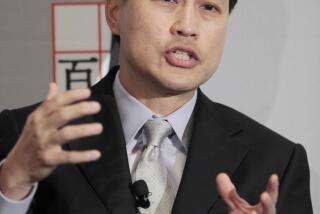SunAmerica-AIG Union Is Matchmakerâs Dream
By the time they arrived at Key Largoâs exclusive Ocean Reef Club earlier this month, the top executives of the freshly merged SunAmerica and AIG knew the game plan. And it didnât involve another round of corporate golf.
While many mega-mergers of the last few years have been marked by months of wrangling and jockeying for power, the two days in January were designed to briskly map a blueprint for the $18.3-billion melding of Los Angeles-based retirement-savings specialist SunAmerica Inc. and New York-based American International Group Inc., a worldwide insurance giant.
As SunAmerica founder Eli Broad and AIG chief Maurice âHankâ Greenberg began bluntly assigning roles for about 40 executives in the merged company--âThis is your new jobâ--people pretty much nodded, âThank you very much.â
Some SunAmerica executives, comfortable with their companyâs more entrepreneurial style, arrived in Florida nervous that they were about to be swallowed up by a global bureaucracy. But instead they found AIGâs people âwere just as direct as we are,â as one SunAmerica exec put it. âItâs âgoâ time.â
After a year in which some of the largest mergers in financial services history were cursed by falling stock prices, fleeing top officials, layoffs and image problems, the combination of SunAmerica-AIG has been a rose garden by comparison, at least so far.
Since the deal was announced Aug. 20, AIGâs stock has risen 18% to $102.94 now on the New York Stock Exchange, and it recently hit a record $107.94. By contrast, shares of BankAmerica Corp., formed by the merger of NationsBank and BankAmerica last year, have slumped 24% from their 1998 high price. Shares of Citigroup, created when Citicorp and Travelers merged, also are down 24% from their peak last year.
*
Unlike most mergers, the SunAmerica-AIG alliance has resulted in few layoffs (well under 100). In fact, it will eventually add hundreds of people to the payroll--especially at 2,500-employee SunAmerica, already the largest financial services firm headquartered in Los Angeles. It is expected to remain based here, part of the merged firmâs global team of 42,500 employees.
Certainly, some things are changing. Many people expect some top SunAmerica talent, armed with new wealth thanks to the merger, to leave. Even longtime Chairman Broad, 65, may be considering his careerâs next phase now that heâs worth an estimated $3 billion and no longer running a public company.
But on the whole, analysts say this deal has been one of the most successful of 1998âs record merger wave, meshing two firms with different specialties but similar entrepreneurial cultures, each with things the other desperately wants.
SunAmerica has become a U.S. leader in retirement-savings products, especially annuities--accounts that offer investors the benefit of tax deferral and an insurance element, and which also tend to generate high fees for the companies sponsoring them.
But SunAmerica had virtually no foreign presence. It was considering going global by forming SunAmerica International last summer. Now it expects to take advantage of AIGâs operations in 130 countries and its AAA credit rating. AIG, meanwhile, was enticed by SunAmericaâs expertise and fast-growing sales in annuities and by its small but growing mutual fund business, with more than $3 billion in assets.
While AIGâs staple--the property and casualty insurance business--has remained relatively flat in recent years, SunAmericaâs business is booming, with total sales up 60% last year to $8.5 billion. SunAmericaâs return on equity, which measures net income relative to shareholdersâ capital, was 19.9% last year, significantly higher than AIGâs.
Architects of the merger expect SunAmericaâs faster sales and earnings growth to speed up the growth rate at AIG, which has long been a Wall Street darling.
âThis, unlike bank mergers, is not an expense story. We didnât put two institutions together and say, âHey, we can save $600 million,â â Broad said in a recent interview. âThis is a growth story. I want people to look back on this in five years as a successful deal that made business sense and economic sense, one that worked. As opposed to those that didnât work as well--and there have been a few of those around this town,â he said.
Wall Street is eager to see how the merged entity will fare in its first major joint venture: SunAmericaâs rolling-out of annuities in Japan via AIGâs insurance sales network there.
âSunAmerica was hired to put sizzle in the story of AIG,â said Charlotte Chamberlain, an analyst with Jefferies & Co., a Los Angeles investment bank. âHank thinks that Weill and Reed [Sanford Weill and John Reed, the Travelers and Citicorp chiefs] donât have the template for world financial domination. There is another way to skin the global cat.â
Unlike Weill and Reed, Greenberg and Broad do not plan to share power, but rather combine Broadâs annuity know-how with Greenbergâs massive sales machine.
*
Broadâs Century City office, a light-filled 38th-floor corner with views of the ocean and the new Getty Center, has two paintings of downtown Los Angeles by artist Mark Innerst, as well as some of the other modern works he is so fond of. Hallways are crowded with art.
Broad, who helped build downtownâs Museum of Contemporary Art, is a longtime collector. When asked if AIG or Greenberg is adopting any of SunAmericaâs modern-art bent, Broad paused.
âHank is a little more traditional when it comes to art,â he said.
But contrary art sensibilities are among the few differences between the two leaders.
These no-nonsense men of more or less the same generation have known each other for about 10 years, often meeting at industry events. Greenberg, 73, is only the second CEO in AIGâs 80-year history. He approached Broad last spring about a merger, meeting him at Broadâs New York penthouse apartment.
At the time, Broad said he was too busy to be interested. By July, however, Broad became intrigued after discovering how expensive it might be to start his own global push. The two began urgent talks.
Insiders say the two respect each otherâs experience and bottom-line focus. Greenberg says simply, âWe get along fine.â
While some question whether Broad will be content being CEO of a unit, rather than the parent company, Broad himself does not.
âThereâs one CEO here. Heâs the best, and his name is Hank Greenberg. Iâm pleased to be a member of his team,â Broad said. âIâve been running a public company since 1961--thatâs a long time. And frankly, Iâve been there, done that with the analysts, the conference calls, the quarterly financial results. That was fun for a while, but the fact that AIGâs doing that now just suits me fine.â
Broad said that several times after something he proposed was rejected by Greenbergâs people, Greenberg told him to use his best judgment and proceed. âSo weâre operating as an autonomous unit; weâre based here and weâre going to stay here,â Broad said.
Still, speculation persists that Broad will leave. Some note that he has many irons in the fire, with new civic projects such as his plan to help bring an NFL team to a downtown L.A. stadium, and his major financial support of the Democratic Party.
Others point to his track record: After making Kaufman & Broad, the home builder he founded in 1957, into a California powerhouse, he moved on to a small insurance firm and transformed it into SunAmerica. Now, in the wake of the AIG merger, some predict he will be looking for his third challenge.
But Broad says heâs already got one. âI wish someone would write and tell me what Act III will look like--Iâd like to invest in it,â he said half-jokingly. âNo, this is a third phase. Going international, being part of AIG--thatâs the third phase.â
*
The success of Broadâs third act will hinge in large part on his teamâs ability to crack the international market for retirement savings products.
The first phase of a plan to capture the potentially lucrative Japanese market for retirement-geared investments is already in full swing. Japan is attractive because its aging population has a high savings rate yet relatively few targeted retirement-investment options. Also, many of Japanâs financial institutions are in trouble, and citizens are nervous about putting money into them, experts say.
SunAmerica is in the midst of the regulatory approval process in Japan, hoping to unveil its annuity products there by early summer.
âThatâs a big market,â Broad said. âItâs opening up, and at a time when the Japanese public has lost confidence in its financial institutions.â
Yet some analysts warn that the move could be more difficult than expected, especially if Japanese regulators turn protectionist or if political problems arise.
Greenberg is upbeat. âThis is a process, and so far itâs all going very well,â he said.
Having AIG on its side can only help SunAmerica in Asia: AIG was founded there--in Shanghai, by a young Californian named Cornelius Van Der Starr. More than a third of AIGâs revenue is already derived from the Far East. âWeâve been there a long time,â Greenberg said.
*
SunAmerica plans to sell the more staid âfixedâ annuities in Japan at first--a way to ease investors into a largely unknown product--and introduce a âvariableâ annuity product in the fall.
Whereas fixed annuities guarantee that investors will receive specific payments in retirement, variable annuitiesâ future payments depend on the return on the underlying investments, generally a stock mutual-fund-type account. That could be a tougher sell to Japanese traumatized by a nine-year bear market in Japanâs stocks.
Still in question is whether it will make sense for SunAmerica to create a larger broker network than AIG already has in Japan. Also unclear is whether Sun-Americaâs sales techniques--annuities, it is said, are âsold, not boughtâ--will translate to the Japanese market.
âI think they will be very successful in Japan. Itâs just a question of timing,â said Thomas V. Cholnoky, an analyst with Goldman Sachs in New York. âAIG is firmly ensconced there and has been since after World War II. They have better name brand recognition there than here.â
James W. Rowan, 36, a Sun-America executive who learned at the Florida meeting that he will head the push into Asia, is also confident. Although he was on edge when AIG bought SunAmerica--after all, he had worked for Security Pacific in 1991 when it was dismembered by BankAmerica--he now believes the alliance is a good fit and gives SunAmerica the foreign platform it needs.
âWe believe the [Japanese] regulatory battle, our first hurdle, will go pretty smoothly,â Rowan said. âThis is a long-term game though, a multiyear process. And AIG is a long-term planner. When they say long-term, they are talking 20 years. We like that.â
(BEGIN TEXT OF INFOBOX / INFOGRAPHIC)
AIGâs Hot Streak
Shares of American International Group have rallied sharply over the past year and are higher today than they were when AIG announced its acquisition of SunAmerica last summer. By contrast, shares of Citigroup and BankAmerica, both of which were also involved in landmark mergers last year, are far below their 1998 peaks. Returns on the three stocks since Jan. 2, 1998:
American Intl.: Jan. 29: +40.6
Citigroup: +6.2%
BankAmerica: +12.8%
Source: Bloomberg News
More to Read
Inside the business of entertainment
The Wide Shot brings you news, analysis and insights on everything from streaming wars to production â and what it all means for the future.
You may occasionally receive promotional content from the Los Angeles Times.










